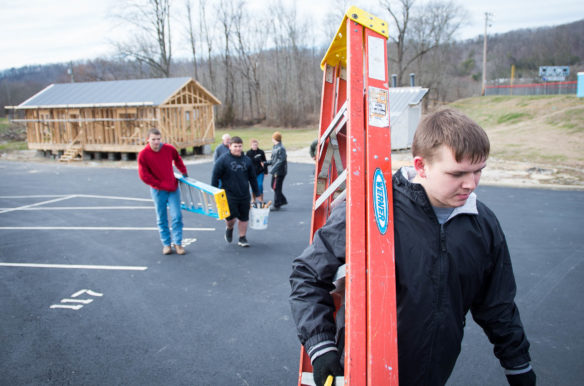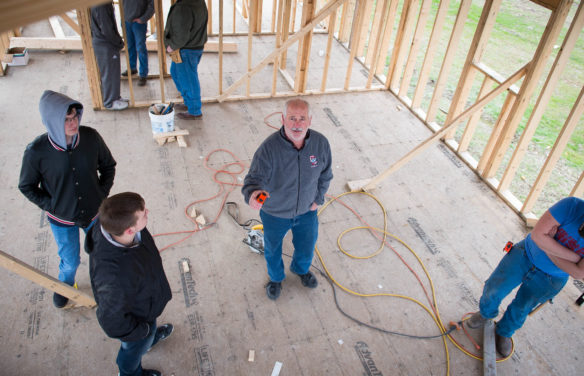
Casey County High School sophomore Chris Propes carries a ladder back to the classroom after working on a tiny house the class is building in the high school’s parking lot.
Photo by Bobby Ellis, Feb. 3, 2017
By Brenna R. Kelly
Brenna.kelly@education.ky.gov
It started as stack of cinder blocks in the parking lot of Casey County High School, but when it’s done, it will be Tara Weddle’s new house.
For the past 20 years, houses have been sprouting from the high school’s parking lot every year. Students in Garlen Whitis’ Fundamentals of Construction class built three-bedroom, two-bath houses which were then auctioned off and moved off the lot by the new owners.
But after building the same house 14 times, Whitis realized his students weren’t learning the problem-solving skills he wanted them to glean from planning a construction project.
“You want to solve a problem the best you can and once you do that five, six, seven or eight times, you make all the corrections you can make,” said Whitis, who has been teaching construction technology for 27 years. “We had improved it so much, it was just hard to improve it anymore.”
Plus, the 1,250-square foot houses were too big for some in the rural county and too small for others. So Whitis decided to go tiny.
“The little house idea has taken over and so we just decide, gosh, I think we’ll try it,” he said.
So this year, Whitis’ 15 students are building a tiny house. At just 800 square feet, the house is about one-third of the median size of a newly built, single-family home in the U.S., according to the U.S. Census Bureau.

Garlen Whitis gives instructions to his students who are working on a tiny house. Whitis’ classes have been building houses for the past 14 years, but this was the first year they decided to build a tiny house. Photo by Bobby Ellis, Feb. 3, 2017
Tiny houses started gained in popularity in the economic downturn in 2008 and have garnered a loyal following that has spawned television shows like “Tiny House Nation” and “Tiny House Hunters.”
Though tiny houses are just small part of the housing market, all newly built houses are getting smaller according to the U.S. Census. The median size of new homes peaked in 2006 at 2,316 square feet, before dropping to 2,158 square feet in 2015.
Casey County isn’t the only Kentucky school district to use the tiny house craze to enhance its construction instruction. Several districts in eastern Kentucky are working together to build three tiny houses as part of a program that brings together math, design, sociology, economics and science, according to the Kentucky Valley Educational Cooperative, which serves 19 districts.
The houses are being sold in an online auction that will conclude in mid-June.
In Casey County, Whitis built tiny houses last summer to donate to flood victims in West Virginia after record-breaking rainfall led to devastating floods.
“I got to thinking, ‘Here we are sitting around Green River Lake and Lake Cumberland and a lot of people come here to hunt,’” he said. Those tiny houses could be used in and around Casey County as hunting cabins, vacation homes or mother-in-law quarters, Whitis said.
Before embarking on the tiny build, Whitis’ students researched small houses and the housing market in Casey and surrounding counties, he said. The students also studied floor plans and designs of tiny houses to create their plan.
The students planned the house to be a little smaller. When Weddle – a business teacher and the girls’ basketball coach at the school – heard about the plans, she told Whitis’ that she would buy it if he made it a little bigger.
“They built it on contract for me,” said Weddle, who wanted to stop renting and own her own home.
When the house is mostly complete in May, Weddle plans to have it moved to her family’s farm and set over a basement. The house has one bedroom, a bathroom that can be entered into from the hallway or bedroom, and an open kitchen and living room.
“I have some of the kids who are building it in my class. They would bring me up the plans and ask me questions,” she said.
She’d also visit Whitis and the students building her house during her planning period to check on the construction. Not long ago, Weddle was one of Whitis’ students. She still has the desk she built in his woodworking class.
“It was probably my favorite class in high school,” she said.
By Weddle buying the house, Whitis was able to add an element he’d been hoping to implement in his construction class for a while.
“They are working for somebody besides me now,” he said. “It gives them a little more accountability. It adds a little more seriousness to it. They know it’s somebody else’s.”
Weddle isn’t the only one who has taken note of the tiny house.
“It’s generated some interest,” he said. “There are people who are coming through saying, ‘Wow, I need a house like that.’”
Whitis is quick to point out that his students won’t be master carpenters when they finish building the house. Fundamentals of Construction is designed to be an exploratory class, he said.
“We’re looking at construction and the whole field,” he said. “All the way from laying out the site, to pouring concrete to the finish work.”
The students design the layout and research what materials to use in the home. But they only do each thing once, he said.
“We’re only doing one house,” he said. “We’re teaching more of the process and the thinking, instead of the skills.”
Building the tiny house has allowed his students to learn more about planning for construction and different ways of finishing than they did with the larger house because it’s all new this year, said Whitis, who in addition to the construction class also teaches manufacturing, foundations of technology and production classes, as well as an all-girls woodworking class.
The house build has to be approved by the Casey County Board of Education each year, but Whitis anticipates asking to do another tiny house next year.
“It’s generated a lot of interest compared to what we were doing,” he said. “It’s really worked well here.”
MORE INFO…
Garlen Whitis Garlen.Whitis@casey.kyschools.us
Tara Weddle Tara.Weddle@casey.kyschools.us








Leave A Comment